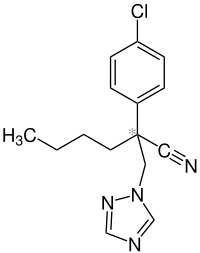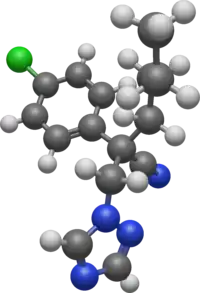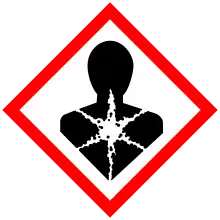Myclobutanil
 | |
 | |
| Names | |
|---|---|
| IUPAC name
2-(4-Chlorophenyl)-2-(1,2,4-triazol-1-ylmethyl)hexanenitrile | |
| Identifiers | |
CAS Number |
|
3D model (JSmol) |
|
Beilstein Reference |
7138849 |
| ChEBI | |
| ChemSpider | |
| ECHA InfoCard | 100.101.000 |
| EC Number |
|
| KEGG | |
| MeSH | Systhane |
PubChem CID |
|
| RTECS number |
|
| UNII | |
| UN number | 3077 |
CompTox Dashboard (EPA) |
|
InChI
| |
SMILES
| |
| Properties | |
Chemical formula |
C15H17ClN4 |
| Molar mass | 288.78 g·mol−1 |
| Appearance | Pale, yellow, translucent crystals |
| Melting point | 63 to 68 °C (145 to 154 °F; 336 to 341 K) |
| Boiling point | 202 to 208 °C (396 to 406 °F; 475 to 481 K) at 130 Pa |
Solubility in water |
142 mg⋅dm−3 |
| Hazards | |
| GHS labelling: | |
Pictograms |
   |
Signal word |
Warning |
Hazard statements |
H302, H319, H361, H411 |
Precautionary statements |
P273, P281, P305+P351+P338 |
| NFPA 704 (fire diamond) | |
| Flash point | > 100 °C (212 °F; 373 K) |
Except where otherwise noted, data are given for materials in their standard state (at 25 °C [77 °F], 100 kPa).
Infobox references | |
Myclobutanil is a triazole chemical used as a fungicide. It is a steroid demethylation inhibitor, specifically inhibiting ergosterol biosynthesis.[1] Ergosterol is a critical component of fungal cell membranes.
Stereoisomerism
| Myclobutanil (2 stereoisomers) | |
|---|---|
-Myclobutanil_V1.svg.png.webp) (S)-configuration |
-Myclobutanil_V1.svg.png.webp) (R)-configuration |
Safety
The Safety Data Sheet indicates the following hazards:
- Suspected of damaging fertility or the unborn child.
- Toxic to aquatic life with long lasting effects.[2]
The first hazard has caused this chemical to be placed on the 1986 California Proposition 65 toxics list.
When heated, myclobutanil decomposes to produce corrosive and/or toxic fumes, including carbon monoxide, carbon dioxide, hydrogen chloride, hydrogen cyanide, and nitrogen oxides.[3][4]
Banned for cannabis cultivation
Myclobutanil is banned in Canada, Colorado, Washington, Oregon, and Oklahoma for the production of medical and recreational cannabis. In 2014, a Canadian news investigation by The Globe and Mail reported the discovery of myclobutanil in medical cannabis produced by at least one government licensed grower.[5] In September 2019, NBC News commissioned CannaSafe to test THC cartridges for heavy metals, pesticides, and residual solvents like Vitamin E; pesticides, including myclobutanil, was found in products from unlicensed dealers.[6] In Michigan, the current state action limit for myclobutanil is 200 ppb in cannabis products.[7]
References
- ↑ "Myclobutanil Product Sheet". Kingtai Chemicals Co.
- ↑ "SAFETY DATA SHEET Myclobutanil" (PDF). Cayman Chemical Company. Retrieved 11 August 2021.
- ↑ GOV, NOAA Office of Response and Restoration, US. "MYCLOBUTANIL - CAMEO Chemicals - NOAA". cameochemicals.noaa.gov.
{{cite web}}: CS1 maint: multiple names: authors list (link) - ↑ "Product Safety Assessment: Myclobutanil".
- ↑ "Canadians not told about banned pesticide found in medical pot supply" – via The Globe and Mail.
- ↑ "Tests show bootleg marijuana vapes tainted with hydrogen cyanide". NBC News.
- ↑ "Technical Bulletin".
External links
- Myclobutanil in the Pesticide Properties DataBase (PPDB)
- International Programme on Chemical Safety
